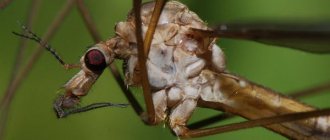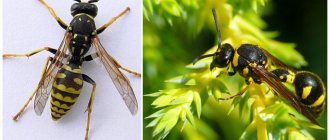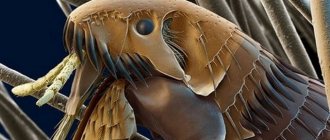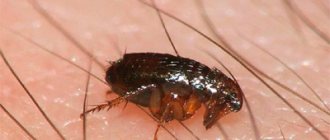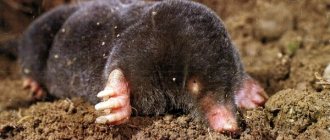Is blood included in the centipede's diet?
For many people, the sight of a large mosquito with long legs causes panic. After all, people don’t know how dangerous the large centipede mosquito is. To understand this, it is necessary to study their taste preferences and structural features. Although these insects have a long proboscis, they are not dangerous to humans. After all, they receive nutrients not from blood, but from plant sap. To obtain nectar, the largest mosquitoes destroy the integrity of the root system, plant stems or algae.
Features of the insect
Centipede is what people call large mosquitoes. The scientific name for large insects is caramora. Large mosquitoes belong to the order Diptera, as well as long-whiskered ones. Karamora received such an interesting name because of its long legs. Since the body of the centipede has a small diameter, the caramora has an awkward and frightening appearance. Scientists often call thin legs limbs. Blood-sucking pests of other families do not have such an interesting feature.
The largest mosquito has an interesting feature that is rarely found among insects. Pests with long legs have a special defense mechanism with which they escape from predators. Few people know what this mechanism is called. Entomological scientists called this feature autotomy. The essence of this protection is that a huge mosquito discards a leg captured by a reptile or bird. This allows him to save his own life. A similar principle of protection is found in lizards that discard their tail.
Some species of mosquitoes are similar to the largest mosquitoes. This makes it difficult for people to know if a large mosquito is dangerous to them. After all, it is difficult for them to distinguish Karamora from a pest that carries infectious diseases.
The long-legged mosquito is found in autumn, spring, and also in summer. In winter, the Karamora falls into torpor or a kind of suspended animation. This process continues until the ambient temperature rises to a certain point. The speed at which pests fly is low. You can find caramora near water bodies and in dense thickets of bushes.
Malaria insect
There is another type of mosquito, the size of which also does not allow it to go unnoticed (on average up to 1 cm). It is called malarial, and its external features are similar to the centipede, which is why they are often confused. It received this name due to the fact that it has the ability to carry the malaria pathogen and infect a person with this disease through a bite.
Malaria insect
The malaria mosquito belongs to the Diptera family and is found everywhere, with the only exception being Antarctica. There are about 10 varieties in Russia. The body of the insect in question is oblong in shape. The head is small and has a long proboscis. The appearance is characterized by long legs and scaly wings. The latter, when not in flight, can be folded horizontally relative to the body. You can also find them with spotted colors.
They have several pairs of legs, and the hind limbs are much longer than the front ones. On the head, in addition to the sting, there are also antennae. They are long enough, which makes it possible to recognize the malaria mosquito. Before landing on a person, the mosquito makes characteristic circular movements in the air during flight. Insects reproduce exclusively in bodies of water, and not everyone is suitable for this process. The water must be clean; there may be very few plants at the bottom. Representatives love only filamentous algae; they allow the larvae to be hidden from predators.
Bloodsucker
From the laid eggs, larvae emerge that have a well-developed body and head. The head contains a large number of special devices in the form of brushes, which are used to absorb food. The body is visually divided into segments, but there are no legs, even false ones.
Due to the peculiarities of the respiratory system, when in water they are located parallel to the surface. Respiratory processes are carried out using spiracles, due to which the larvae often have to surface to absorb air.
They usually live in shallow bodies of water that are well lit. The optimal temperature depends on the type of malaria mosquito, and therefore varies from 10 to 35 degrees.
Having become familiar with the characteristics and distinctive features of the largest mosquitoes, you can safely go for a walk. It is recommended to respond adequately to large insects of this family and only if necessary resort to certain protection and safety measures.
Harm from centipedes
However, one cannot say that this large mosquito is completely harmless. Without being a direct danger to humans, the centipede is capable of causing significant damage to forestry and agriculture. Some types of caramora are recognized as dangerous pests that attack fruit, vegetable and berry crops.
Thus, the larvae of the cabbage weed, living in the upper layers of the soil, feed on the roots of plants during the day, but at night they climb to the surface of the earth and gnaw leaves and stems. The marsh centipede also causes similar damage to vegetation.
Damage occurs most often in open ground, but sometimes even in protected ground, where larvae and eggs fall along with the introduced soil.
Precautionary measures to combat this pest are usually the following: treatment of seed materials and soil with special compositions during periods of egg laying and pupation of larvae. It is also effective to place special baits on the site, treated with a substance that is fatal to the larvae.
Waterlogged areas should be drained, the water level in the drainage system should be systematically adjusted, and weeds should be actively controlled. Taken together, such actions are quite effective in combating the damage that this large mosquito can cause to agriculture.
Life cycle of centipede
One generation develops per year. Centipedes begin to fly in July and until September, the peak being in August.
The third instar larvae remain in the upper layers of the soil for the winter. In the spring, when it gets warm, the larvae begin to actively feed, which is why the crops suffer greatly. During the day the insect hides in a hole and at night comes out to feed.
Females lay eggs in dense layers of soil covered with grass. The eggs have a smooth black shell and are approximately 2 mm long. They ripen in about 10-15 days. Female centipedes are highly fertile; they manage to lay 500-1000 eggs.
As already mentioned, centipedes live in conditions of high humidity; if a drought sets in, many of the eggs laid become unviable.
Centipede (larva)
Centipede larvae are worm-like, cylindrical in shape and earthy gray in color. The larvae do not crawl far from the place where they were born. At an older age, they reach a length of 3.5-4.5 cm. The full development cycle of the larvae is 11 months.
The anterior part of the larvae is narrow, with a small, underdeveloped head. 2/3 of the head is immersed in the prothoracic region. There are no thoracic legs; for movement in the rear part of the body there is a pusher with a pair of lateral outgrowths. Three pairs of processes are located near the spiracles.
The larvae are born and develop on land; in the first instar they feed mainly on humus and leaves, without causing them serious harm.
Before the beginning of October, the larvae molt twice, and then go deep into the soil for the winter. Development continues after winter.
In July, the larvae pupate, the size of the pupa is 2.8-3 cm, the color of the pupa is brown. On the abdomen you can see transverse rows of small spines. The pupal phase takes 12-15 days, after which young adults emerge from the ground.
External signs
The Karamora mosquito has faceted and black eyes. Insects do not see the shade, they feel the warmth that comes from plants and people. The head, on which the long antennae are concentrated, is small in size. It is easy to distinguish a female from a male by the body. In the female, the red abdomen consists of 10 segments or letters. It's a little elongated. Therefore, females are often called ballerinas, because they look like these amazing dancers. Males have a larger abdomen, although the number of segments is the same.
These insects have wings that are almost transparent and of considerable length. Some subspecies differ in that spots are concentrated on the wings. The second pair of wings eventually transformed into halteres. The largest mosquitoes need them to move unhindered through forests. The oral apparatus does not include the chitinous teeth that mosquitoes and squeakers have. With the help of the proboscis, the centipede penetrates under the plant layer and extracts nectar. The facts that confirm whether large mosquitoes bite people or not are given by scientists.
External features
Features of representatives of this species:
- sizes up to 10 cm;
- predominantly gray in color;
- elongated head with noticeable mustache;
- two pairs of wings;
- elongated limbs.
Large mosquitoes have an elongated and elongated body. The color is predominantly gray, but there are individuals of a yellowish-brown color. The centipede mosquito has two pairs of wings. Large wings can be spotted and serve directly for movement in the air. The hind wings serve as a body stabilizer during flight and are short processes.
The dimensions of the elongated legs of the caramora are determined by the elongated shin. The proboscis is short and soft, and is designed to collect dew. It does not bite humans, despite its terrifying appearance.
The long-legged mosquito has gray larvae with small false legs and gills. It lays eggs in places with high humidity. The clutch can be found in moss, rotten leaves and soil.
Centipede development stages
Adult flight occurs in mid-July. Females mate with males, and eggs are formed inside within a few days.
The mosquito lays numerous eggs in damp, moist soil. Clay substrate, turf, and peat are suitable for these purposes. At temperatures above 15 degrees Celsius, the larvae develop within 15 days. At the last stage they pupate. After half a month, adult adults appear. A huge mosquito produces only one population per year. In tropical countries, reproduction occurs constantly.
Larvae
Whether a large mosquito with long legs is dangerous or not can be judged by how much harm its larvae bring to humans. Females lay eggs in the soil, rotten wood, and under fallen leaves. These “fry”, dirty brown or gray in color, cannot be called cute by any stretch of the imagination.
However, much worse is their incredible gluttony. If large mosquitoes in Moscow consumed food on the same scale as in childhood, the capital's vegetation would be in trouble. Among the favorite “delicacies” of the larvae:
- plant roots;
- tree seedlings;
- rotting leaves;
- seaweed.
For residents of rural areas, the question of whether large mosquitoes are dangerous does not arise. Even if you do not take into account the risk of being bitten, the very presence of such insects means that larvae are developing somewhere nearby, for which garden plants are a very welcome treat.
Appearance and features
Photo: What a centipede mosquito looks like
Long-legged mosquitoes (Tipulidae) are insects belonging to the Diptera family, suborder long-whiskered. They represent the largest mosquito species and reach a maximum body length of almost 40 mm, and a wingspan of more than 50 mm. Despite their size, weevil mosquitoes have a very slender body and narrow wings.
The external color usually varies from gray to brown, in some genera it can be yellow and even black and yellow or black and red. The wings are most often black in color and are laid back in the resting position. Like all dipterans, the hind wings turn into swinging joints (holders). In some species, the forewings are stunted. Their antennae have up to 19 segments. The insect also has a different V-shaped suture on its thorax.
The head is retracted, in the form of a “stigma”. It moves forward, making the proboscis very soft and capable of absorbing only liquids. The posterior end is clearly thickened and carries male fertilizing cells and female egg-laying cells, formed from the abdominal appendages. There are long antennae on the head.
Long legs are affected, which often have predetermined breaking points and, accordingly, quickly break off. They are very elongated. In long-legged mosquitoes (with the exception of the genus Indotipula, the legs have large processes called spurs. In addition to two large compound eyes, some species have rudimentary ocelli on the head.
Now you know whether the centipede mosquito is dangerous or not. Let's see where these insects are found.
Where does the giant with long legs live?
Large mosquitoes are found on many continents. The only exception is Antarctica. The climate on this continent is not suitable for reproduction and existence. People who live in Russia know exactly what kind of insects large mosquitoes are and how they differ from mosquitoes.
Large mosquitoes live:
- Near swamps and ponds with standing water.
- In forest areas.
- In dense bushes.
When selecting a place for existence and reproduction, the caramora chooses those places where the humidity level is quite high. At the same time, the centipede hides from the sun's rays. Such insects are never found in places where there are no ponds or other sources of water. This is because they require moisture for normal development.
To lay eggs, the caramora selects areas with moist soil or fresh foliage. After all, larvae and pupae require moisture for normal development. If there is no access to water or moisture, then the development period can increase significantly.
Geographical distribution and habitat
The harmful centipede can be found in woodland, in the western part of the forest-steppe and steppe zone (on lands where irrigation is present).
The species is distributed on the territory of the North American continent, in Europe, in the countries of the former USSR, including in the European part of the Russian Federation.
Eggs and larvae require a moist environment to live. They do well in:
- peat and clay soils;
- turf soil with high humidity;
- grass, especially wet;
- low-growing dense bushes;
- rotting plant substrate;
- swamp and wetlands;
- damp basement or basement.
The eggs of long-legged mosquitoes survive the winter without any problems. For a successful wintering, middle-aged larvae only need to settle in the surface layers of the soil.
Harmful centipedes willingly settle in forests, parks and other biotopes with tree plantings. An important condition is the presence of a fresh water body (swamp, lake, pond or river) in the habitat area. Insects feel comfortable in soils with a moisture content exceeding 55%.
How does the centipede mosquito reproduce?
A kind of proboscis, which is required for laying eggs, is concentrated on the abdomen of a hefty insect. Using the spout, females place eggs under foliage or in moist soil. Huge mosquitoes perform such actions in order to preserve the clutch and prevent the death of offspring. Since pests lay a lot of eggs, the population of centipedes is rapidly increasing.
When choosing a place for laying, caramora chooses wet places. The eggs are placed in a peculiar shell, which has a black tint and a dense structure. The formed larvae of the large centipede mosquito move to bodies of water, as well as to rotting vegetation. At the next stage, a pupa is formed, which is distinguished by its cylindrical shape and the presence of spines. The pupae use these spines to get out of the soil and penetrate into the rotten bark of trees.
Many people wonder why large mosquitoes are dangerous. After all, their appearance often causes panic attacks. Large mosquitoes do not bite people to get more blood. After all, to raise offspring they require other nutrients. Scientists have given an exact answer to the question of whether they are dangerous or not.
Where does the centipede mosquito live?
Photo: Insect mosquito centipede
Insects live everywhere on all continents. They are absent only in arid waterless areas, on small oceanic islands with year-round ice or snow cover, and also in the center of the Arctic + Antarctic. The world's fauna numbers approximately 4,200 insect species. These highly visible creatures are represented by a wide variety of species in virtually every biogeographic region (excluding Antarctica).
The number of species present was distributed by region as follows:
- Palearctic region - 1280 species;
- Nearctic kingdom - 573 species;
- neotropical region - 805 species;
- Afrotropical region - 339 species;
- Indo-Malayan zone - 925 species;
- Australasia - 385 species.
The larval habitats are concentrated in all types of freshwater and semi-saline environments. Some species are found in moist cushions of mosses or Marchantia mosses. Ctenophora Meigen species are found in rotting wood or turf logs. And the larvae of such species as Nephrotoma Meigen or Tipula Linnaeus are frequent guests of dry soils of pastures, steppes and lawns.
Larvae of the Tipulidae group are also found in rich organic soil and mud, in damp forest areas where there is a lot of rich humus, in leaves or mud, decaying plant parts or fruits that are in various stages of decay. Larvae play an important role in the soil ecosystem as they recycle organic material and increase microbial activity in sediments.
Dietary features, habitat
The large mosquito in Russia is found in forested areas, swampy areas, near rivers and lakes. Less commonly seen near a private house, in a meadow. But some species willingly live in the garden and vegetable garden.
The insect receives the bulk of its nutrients at the larval stage, so some of them, as adults, do not eat anything at all. In most cases, the centipede mosquito feeds on flower nectar. A long proboscis is specially adapted for these purposes. The larvae feed on rotting grass and sap.
Feeding characteristics of mosquitoes and larvae
The main food of the insect is nectar, which comes through the proboscis. The same organ collects dew. There are some varieties of centipedes that do not need food.
As for the larvae, they feed by eating agricultural products, causing damage.
This refers to the marsh centipede called the ballerina. The larvae feed on vegetables and grains.
Cabbage weed larvae are deposited in black soil. They feed on plants that develop underground:
- carrot;
- potato;
- beet.
However, with warming, it comes to the surface and eats growing cabbage leaves. This is where its name came from.
What does it eat?
There are many myths about red mosquitoes related to the fact that they bite people and these bites are painful. But even if the pest bites, its bite does not cause any harm to a person. If a mosquito bites, then without proper treatment an infection develops, swelling or redness occurs. People who encounter Karamora may feel scared. Most often, those who are not aware of the existence of the centipede are frightened.
The main food for the centipede is nectar or plant juice. Caramora larvae feed on living plants. To do this, they approach the root system, which is located in moist soil. Farmers and owners of agricultural fields note that caramors periodically cause significant harm, destroying certain crops.
The biting reddish pest is often encountered by summer residents and owners of country houses. In the evening, caramora is located in dense bushes and wet grass. If a person who is not familiar with this amazing insect comes across a centipede, he may be scared. A pest that gets into an apartment or country house hides. To do this, it uses places where the color of the sun does not penetrate.
Measures to combat centipede
The fight against larvae requires an integrated approach. To exterminate the pest, the use of insecticides and poisoned baits should be combined with drainage of wetlands and deep fall plowing.
Agrotechnical measures
Agrotechnical measures that help fight the harmful centipede include:
- ensuring proper technical care of the drainage system of drained floodplain lands;
- systematic adjustment of the water level in the drainage system;
- weed control;
- reducing soil acidity by liming;
- timely, high-quality processing of row crop spacing;
- implementation of deep autumn plowing after harvesting.
Chemical method
This method of pest control involves timely treatment of the beds with the following preparations:
- pyrethroids;
- organophosphorus compounds;
- neonicotinoids.
It is recommended to treat the seed material with heptachlor and hexachlorane.
Before the larvae reach an older age, when they become less sensitive to pesticides, you should resort to setting traps.
Baits can be made from wood shavings and maize, which are sprayed with heptachlor. They are placed in early spring or autumn.
In an infected area, at the time of planting, granular preparations are introduced into the soil. They are based on the enteric contact insecticide diazinon. The most common of them are Thunder and Medvetox.
In field conditions, larvae are exterminated with a hexachlorane solution (12%). The product should be sprayed in the evening. At this time, the pest appears to feed.
Biological method of control
A biological method can also be used to combat harmful centipedes. It involves releasing the nematodes Steinernema carpocapsae onto the fields. They are excellent at eliminating caramora larvae.
The harmful centipede belongs to the mosquito family. It is also called caramora. The insect does not pose a threat to people, but it harms agricultural crops. Mass reproduction of the pest threatens damage to cereals, flax and vegetable crops. The fight against centipede should be comprehensive.
Fighting methods
Agrotechnical measures and the use of special chemicals will help protect crops from the pest.
Agrotechnical methods:
- Drainage of swampy meadows and fields.
- Deep fall plowing after harvesting.
- Regular maintenance of the drainage system, monitoring the water level.
- Liming of acidic soil.
- Getting rid of weeds between seedlings and along the edges of irrigation canals.
- Plowing between rows during the period of oviposition by female centipedes.
Chemicals
It is recommended to treat seeds with heptachlor and hexachlorane. Before the larvae reach an older age and become insensitive to poisons, it is necessary to lay out traps. Baits made from sawdust and corn are treated with heptachlor. They are laid out in fields in early spring or autumn. In infected gardens, when planting seedlings, granular products based on the enteric insecticide diazinon are placed in the soil. Such drugs are used against weevils, wireworms, and mole crickets. The most famous are “Grom” and “Medvetox”.
In the fields, the larvae are destroyed with a 12% hexachlorane solution. The substance is sprayed in the evening, when pests appear to feed. In some cases, they resort to a biological method of ridding the field of pests - nematode larvae are released into the infected area.
Do they bite or not?
The most important questions that haunt many adults and children: do large mosquitoes bite people and what will happen if a large mosquito bites? The fear of this insect is completely justified; seeing a mosquito of such impressive size is difficult to remain calm. However, there is no need to worry, the ballerina does not have piercing bristles, which can be used to pierce the skin. Therefore, the centipede simply physically cannot drink human blood.
The caramora can feed on the nectar of plants thanks to its long proboscis. There are a sufficient number of insects that have absolutely no need for a food source. After emerging from the chrysalis state, the ballerina's main task is to reproduce and lay eggs.
Differences from the mosquito mosquito
Let's look at how the centipede mosquito differs from the malaria mosquito, with which it is often confused:
- Anopheles have a brightly colored abdomen and a brown body. The color of Karamor can be very different, but most often it is gray with various shades;
- When preparing to suck blood, the malaria mosquito places its abdomen at an angle of 45 degrees to the plane of the body, while caramors, if they land on the human body, are located parallel to the surface;
- The huge mosquito has disproportionately long legs, while Anopheles mosquitoes have short legs.
When visually comparing malaria mosquitoes with other species, they have the greatest similarity in appearance with ordinary squeakers, while caramors have sizes that are 3-4 times larger than the size of an ordinary mosquito.
Centipede mosquito: benefits and harms
The most important questions for humanity are whether the Karamora mosquito is dangerous, whether it drinks blood, and whether large mosquitoes bite. Many people mistakenly call it malarial and are terribly afraid. The grass mosquito prefers flower nectar and helps bees pollinate plants. Unlike other species, it does not pose any danger to humans, since it is anatomically incapable of biting through the skin. The statement that it was bitten by a large mosquito is incorrect. The only thing a caramora is capable of is to scare with its appearance.
However, a huge mosquito often turns into a garden pest, causing a lot of trouble and reducing productivity. Fruit mosquito larvae damage berries, apples, plums, cherries, pears, apricots and many other garden crops.
For the garden, the greatest danger is posed by the swamp red mosquito, cabbage mosquito, and autumn mosquito. Before pupation, the larvae begin to feed intensively, replenishing their reserves for the winter. Root crops, cereals, legumes, and tubers are damaged. An insect similar to a large mosquito can destroy rice crops in a season.
What to do if you notice a mosquito with long legs?
Typically, you don't need to do anything! This is an ordinary insect that is completely harmless to humans. If caramora ends up in your house, you need to find out the reason why it got there. If this is an isolated incident, the mosquito may have simply flown in through an open window or door. If Karamors begin to appear frequently, it’s worth thinking about.
The most common reason for the appearance of caramora in the house is the soil in which the eggs were located. Especially if you collected soil for flowers or seedlings somewhere in the forest, and did not purchase it in a specialized store.
Ballerinas lay eggs in the ground, moss, rotten wood and even in water. Therefore, when you bring home soil from the street, you run the risk of bringing along with it Karamor eggs (as well as other pests).
In this case, it is necessary to get rid of the contaminated soil. However, in any case, there is no need to panic - the caramora will not harm you, although it looks a little scary.
Reproduction
Centipedes lay eggs in water, silt, rotting wood, moss, plants, wet soil and fallen leaves. In the process of laying eggs, females jump up and stick the ovipositor into the loose substrate. Soon, gray larvae emerge from the eggs. The larvae have false legs, a well-developed gnawing apparatus and gills. Outwardly, they resemble large-headed worms.
Centipede mosquito larva
In Europe, the most common caramora species is Tipula maxima. They lay larvae on wet leaves, moss and tree bark. There are also caramores of the species Pedicia (larvae are more often found in silt) and Dicranota, the larvae of which have a large number of tentacles, allowing them to move along the surface of the silt. Dicranota larvae are very tenacious, capable of breathing through gills and skin, so they survive even in very clogged reservoirs.
Interesting facts about the large Karamor mosquito
- Karamora lives from spring to autumn.
- It chooses damp places, forests, wetlands, however, it can often be found in the city.
- During the day it is usually passive. With the onset of darkness, it can fly into the room into the light, after which it loses its bearings and rushes about in search of a way out.
- Adults either do not feed at all or eat dew and flower nectar.
- Completely safe for humans.
Now you know the name of a large mosquito with long legs, and also that this insect is completely safe, so you should not panic when you encounter it. You can pick up large mosquitoes - they will not cause you any harm, although they look rather unpleasant.
When you see a caramora on the street, you don’t need to rush to leave or, conversely, try to kill it. Most likely, it will not show any activity or will simply fly away with a wave of a hand or a gust of wind. There is no need to be afraid of it - it will not harm you, and it has nothing to do with malaria.
The largest mosquitoes in the world: the largest species of mosquitoes
According to zoologists, more than 3 thousand species of mosquitoes live on planet Earth; within Russia alone, 100 species of these annoying, and in most cases, blood-sucking insects are found. But among all the diversity, many representatives are harmless to humans and the environment, and we, turning to reference books and encyclopedias, comparing photos and descriptions, decided to find out what the largest mosquito in the world is.
Long-legged mosquitoes / Tipulidae
The largest representatives of the mosquito family are also called caramors, and they live in damp forests near fresh water bodies and in swamps.
You can meet such a mosquito with long legs on all continents of the planet, and, despite their size, they are completely harmless.
Body length ranges from 2 to 60 mm, but some inhabitants of the tropics grow up to 11 cm. So when asked what the largest caddis mosquito is, feel free to answer Karamor.
Types of long-legged mosquitoes
The world's fauna includes more than 4,200 species of long-legged mosquitoes, and for comparison, let's look at the largest representatives.
Holorusia mikado
A huge mosquito of the species Holorusia Mikado from the family Centipede, caught in the Chinese province of Sichuan, is considered to be the largest mosquito in the world today.
The wingspan of this giant of the mosquito world is 11.5 cm, but scientists are still silent about what caused this growth. Entomologist Zhao Li spent a lot of time studying this unique specimen.
The species was first discovered and studied in 1876. Despite its size, the giant mosquito of this species is harmless and flies very poorly.
Festive centipede / Ctenophora festiva
Because of the characteristic coloring of this mosquito from the family Centipedes, it is also called the decorated ctenophora, and they grow from 2 to 2.65 cm.
The body color is grayish-brown with yellow alternating stripes, which makes the mosquito look like a wasp. They live throughout Europe, in Russia, and in Ukraine the species is listed in the Red Book.
It is considered endangered, and the main reason is the cutting down of old forests, which are the natural habitat of the Festive Centipede.
Harmful centipede / Tipula paludosa
The species name itself already indicates that the mosquito is a pest of agricultural land.
The size of an adult individual with incredibly long legs reaches from 2 to 2.4 cm, and the mass of the mosquito does not exceed one gram. Settled in North America, Eurasia. It can be found in any region of Russia and in the countries of the post-Soviet space.
It causes great harm to flax crops, but can also harm other agricultural crops - potatoes, corn, barley.
Other types of mosquitoes
From centipedes, which are rightfully considered record holders in size, let us move on to consider other species of the diverse mosquito world.
Twitch mosquito / Chironomus
A rather large species of mosquito with long legs belongs to the huge family of chironomids from the order Diptera.
They fly in large groups, creating a characteristic hum in the air, and interestingly, this buzzing mosquito swarm consists predominantly of males. It got its name because when it sits on the surface, it twitches its paws.
In Rus', according to their squeak, they were also called Zvonets, and this name was fixed in reference books on entomology. It is completely harmless to humans, since it cannot bite, but it itself serves as excellent food for fish.
Tropical mosquitoes
As such, the name “tropical mosquitoes” is not used scientifically, but this is what we call many representatives of the world of mosquitoes that live in the tropical latitudes of the globe.
Yellow fever biter / Aedes aegypti
Because of its color, this species is also called the tiger mosquito, and it comes from Africa. Over time, it spread throughout the Pacific Islands and South America.
It is dangerous to humans because it is a carrier of many dangerous diseases, including yellow fever, Zika virus and dengue fever. The mosquito's weight is small, and it drinks 3-4 times its body weight in blood.
It can be identified by the characteristic white stripes on its legs. There are the same white stripes on the fore-back. They bite mainly in the evening and at dawn, but in urban conditions they can suck blood during the day.
By the way, mosquitoes are rightfully considered one of the most dangerous insects in the world. You can find out more about this on our website TheBiggest.ru by following the link.
Thick-mouthed mosquitoes / Chaoboridae
These insects prefer to live near water bodies as their habitat, as they belong to the family of long-whiskered dipterans.
Unlike their relatives, mosquitoes, they do not suck blood, and can generally do without food. But the larvae, developing in water, eat small crustaceans and the young of other insects.
These mosquitoes are colored light yellow and appear almost transparent. Mosquitoes grow up to 1 cm in length, and males are distinguished by characteristic feather-like antennae on their heads.
Squeak mosquito / Culex pipiens
It is worth mentioning this species, called the common mosquito in entomology. Although not the largest, it is perhaps one of the most common species of mosquitoes on the planet.
It lives almost all over the globe, and adult individuals grow up to 8 mm. Males feed on plant juices, but females also add human or animal blood to this diet.
During flight, this type of mosquito makes up to 1 thousand wing beats per second, which creates the characteristic, and so annoying, mosquito squeak.
Mosquito: male and female, differences
These insects belong to the category Diptera, the long-whiskered group. In total, more than 3,000 species of mosquitoes are identified. They are divided into 30 genera. In our area you can find up to 100 varieties. What does a male mosquito look like?
He has a thin body: head, chest and abdomen. Most mosquitoes are no more than 15 mm in length. Their legs (three pairs) are long and with claws, and their wings are narrow with veins. The general color of insects can be gray, brown or yellow. Weight depends on the state of satiety and can fluctuate between 1 and 5 mg. The squeak is produced by the vibrations of the wings. Their frequency can reach up to 1000 beats per second in some species (usually from 500).
There are long sensitive antennas on the head. In males they are more “fluffy”. The oral apparatus consists of jaws and elongated upper and lower lips. They form a proboscis groove. Needles formed by underdeveloped jaws move along it. The cavity of the tongue serves as a channel for the passage of saliva containing anticoagulants and anesthetics.
Mosquitoes also have small teeth, which play an important role when piercing the skin of the victim. Females have piercing bristles on their proboscis, which males do not have.



